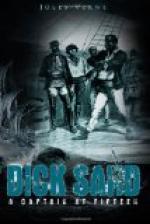THE BEST TO DO.
So then, after a voyage long delayed by calms, then favored by winds from the northwest and from the southwest—a voyage which had not lasted less than seventy-four days—the “Pilgrim” had just run aground!
However, Mrs. Weldon. and her companions thanked Providence, because they were in safety. In fact, it was on a continent, and not on one of the fatal isles of Polynesia, that the tempest had thrown them. Their return to their country, from any point of South America on which they should land, ought not, it seemed, to present serious difficulties.
As to the “Pilgrim,” she was lost. She was only a carcass without value, of which the surf was going to disperse the debris in a few hours. It would be impossible to save anything. But if Dick Sand had not that joy of bringing back a vessel intact to his ship-owner, at least, thanks to him, those who sailed in her were safe and sound on some hospitable coast, and among them, the wife and child of James W. Weldon.
As to the question of knowing on what part of the American coast the schooner had been wrecked, they might dispute it for a long time. Was it, as Dick Sand must suppose, on the shore of Peru? Perhaps, for he knew, even by the bearings of the Isle of Paques, that the “Pilgrim” had been thrown to the northeast under the action of the winds; and also, without doubt, under the influence of the currents of the equatorial zone. From the forty-third degree of latitude, it had, indeed, been possible to drift to the fifteenth.
It was then important to determine, as soon as possible, the precise point of the coast where the schooner had just been lost. Granted that this coast was that of Peru, ports, towns and villages were not lacking, and consequently it would be easy to gain some inhabited place. As to this part of the coast, it seemed deserted.
It was a narrow beach, strewed with black rocks, shut off by a cliff of medium height, very irregularly cut up by large funnels due to the rupture of the rock. Here and there a few gentle declivities gave access to its crest.
In the north, at a quarter of a mile from the stranding place, was the mouth of a little river, which could not have been perceived from the offing. On its banks hung numerous rhizomas, sorts of mangroves, essentially distinct from their congeners of India.
The crest of the cliff—that was soon discovered—was overhung by a thick forest, whose verdant masses undulated before the eyes, and extended as far as the mountains in the background. There, if Cousin Benedict had been a botanist, how many trees, new to him, would not have failed to provoke his admiration.
There were high baobabs—to which, however, an extraordinary longevity has been falsely attributed—the bark of which resembles Egyptian syenite, Bourbon palms, white pines, tamarind-trees, pepper-plants of a peculiar species, and a hundred other plants that an American is not accustomed to see in the northern region of the New Continent.




